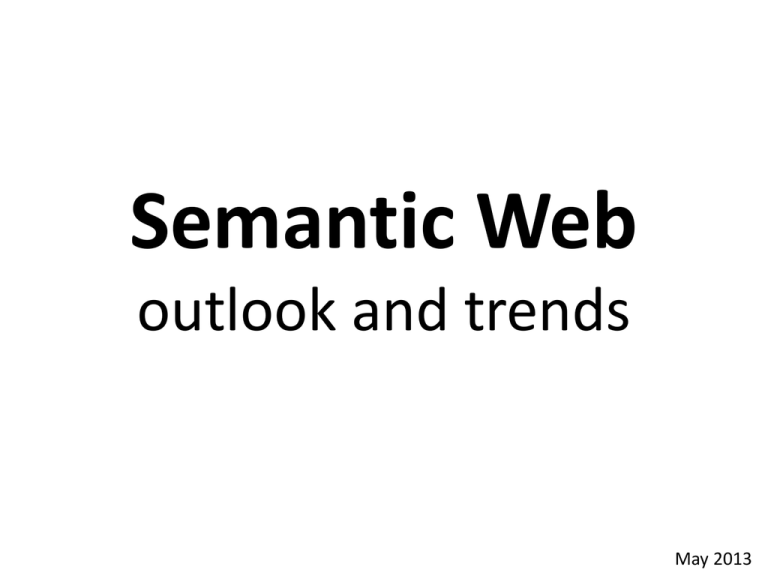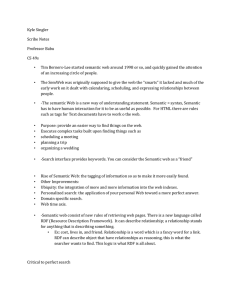Semantic Web outlook and trends May 2013
advertisement

Semantic Web outlook and trends May 2013 The Past 24 Odd Years • 1984 Lenat’s Cyc vision • 1989 TBL’s Web vision • 1991 DARPA Knowledge Sharing Effort • 1996 RDF • 1998 XML • 1999 RDFS • 2000 DARPA Agent Markup Language, OIL • 2001 W3C Semantic Web Activity • 2003 OWL • 2008 SPARQL • 2009 OWL 2 • ~2009 Linked Data • 2012 Wikidata • 2012 Microdata & schema.org • 2013 Rule Inter. Format • 2009- vocabularies: SKOS, PROV, RDB2RDF, … • 2014 JSON-LD The Next 20? ? What’s Hot Here are six areas that I think will be important in the next five years • Linked Data • Semantic Data • Big (Semantic) Data • Populating RDF KBs from text • Schema.org • Wikidata • New application areas Linked Data • RDF is a good data language for many applications – Schema last applications, graph model is easy to map into others, Web oriented • OWL is a poor KR language in many ways – no certainties, contexts, default reasoning, procedural attachments, etc. Current OWL most rely on forward reasoning and don’t handle contradictions well. • Today’s immediate benefits mostly come from shallow reasoning and integrating and exploiting data rather than reasoning with deeper “ontological knowledge” “Semantic” Data • The S word is very popular now • Semantic ≠ Semantic Web • Search companies are competing by better understanding (i) content on a web page and (ii) a user’s query • Facebook benefits from its social graph: you say you attended UMBC, not “UMBC”. FB knows it’s a university, which is a kind of educational institution • Hendler: “A little semantics goes a long way – It’s incremental: don’t try to do it all at once Big (Semantic) Data • The big data theme and the growth of RDF data combine to create a need for better semantic tools that can work at Web scale • Problems include: – Parallel reasoning (Hard, see Webpie paper & letters) – Distributed SPARQL queries – Graph analytics on huge RDF graphs – Machine learning over RDF data – Extracting and using statistical knowledge from RDF Knowledge Base Population • Information extraction involves extracting entities and relations from text • A common model: read lots of text documents and populate a knowledge Base with the entities, attributes and relations discovered – See DARPA Machine Reading Program, NIST TAC Knowledge Base Population track • RDF/OWL is increasingly chosen as the default target for such knowledge TAC 2012 Cold Start Knowledge Base Population Microdata aka Schema.org • It’s significant that the big search companies have embraced an RDF compatible way to embed data in Web pages • They are beginning to detect and expliot the data to provide better services • It demonstrates that it’s not rocket surgery, is easy to add, and is useful • Their measured incremental approach is pragmatic and will open up possibilities for more Wikidata • Wikipedia has been enormously successful and important, making all of us smarter • DBpedia shows its potential to make machines more intelligent • Wikidata aims to better integrate these two and has the potential of creating a knowledge resource with a permeable barrier between the unstructured and structured representations New Application Areas Some application areas will get a lot of attention because they important or new • Cybersecurity – Modeling, sharing and inegrating info. on threats, attacks, vulnerabilities, etc. • Healthcare – Electronic healthcare records, personalized medicine • Social media – Integrating social information on the web or via smart devices • Mobile computing – Modeling and using context, integrating information from phone, web, email, calendar, GPS, sensors, etc. • Ecommerce – E.g., GoodRelations Beyond PDF • Publication is important to all scholarly disciplines, especially STEM areas • Modernizing this is more than putting pdf versions of articles online • There is an interest in also publishing data, services and code and linking these to papers – Capturing provenance is an interesting aspect • We need new author tools, indexing services, search engines, etc. Conclusion • We are still exploring what can be done – and how to do it – and how to do it efficiently – and how to do it easily w/o a lot of training – and how to derive benefits from it (commercial or societal) • The technology and systems will change • It will be a fluid area for another decade or two – or maybe longer










